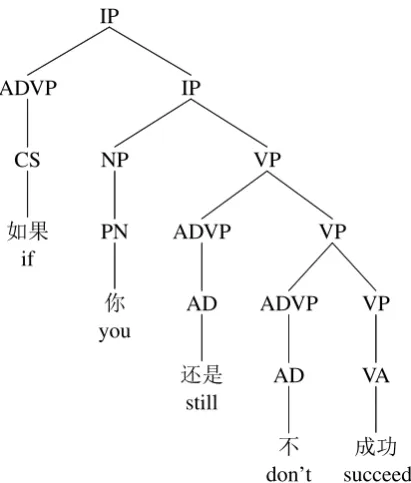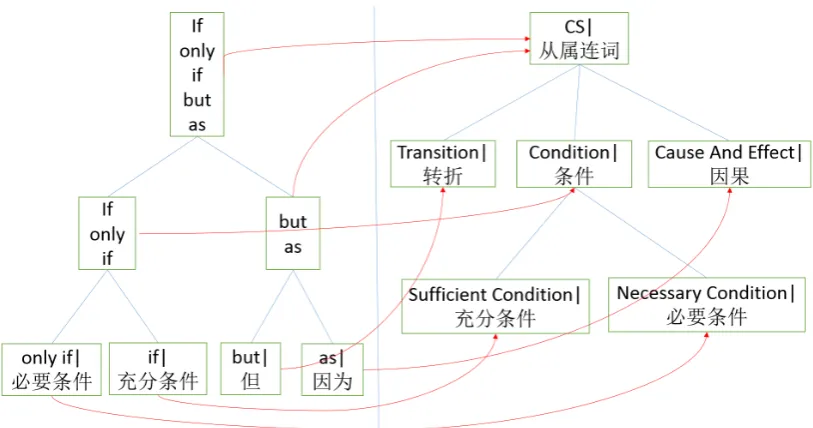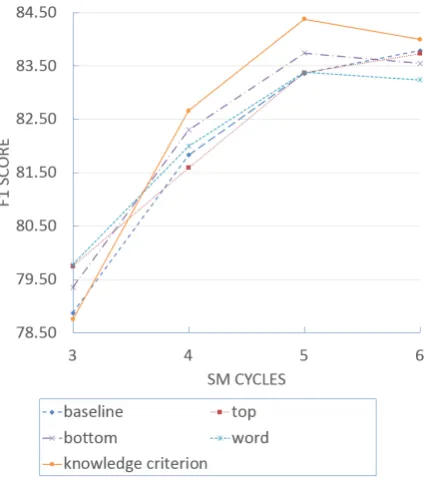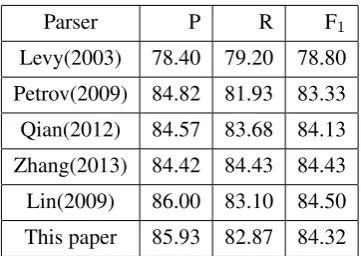Learning Grammar with Explicit Annotations for Subordinating
Conjunctions
Dongchen Li, Xiantao Zhang and Xihong Wu
Key Laboratory of Machine Perception and Intelligence Speech and Hearing Research Center
Peking University, Beijing, China
{lidc,zhangxt,wxh}@cis.pku.edu.cn
Abstract
Data-driven approach for parsing may suf-fer from data sparsity when entirely un-supervised. External knowledge has been shown to be an effective way to alleviate this problem. Subordinating conjunctions impose important constraints on Chinese syntactic structures. This paper proposes a method to develop a grammar with hierar-chical category knowledge of subordinat-ing conjunctions as explicit annotations. Firstly, each part-of-speech tag of the sub-ordinating conjunctions is annotated with the most general category in the hierar-chical knowledge. Those categories are human-defined to represent distinct syn-tactic constraints, and provide an appropri-ate starting point for splitting. Secondly, based on the data-driven state-split ap-proach, we establish a mapping from each automatic refined subcategory to the one in the hierarchical knowledge. Then the data-driven splitting of these categories is restricted by the knowledge to avoid over refinement. Experiments demonstrate that constraining the grammar learning by the hierarchical knowledge improves parsing performance significantly over the base-line.
1 Introduction
Probabilistic context-free grammars (PCFGs) un-derlie most of the high-performance parsers (Collins, 1999; Charniak, 2000; Charniak and Johnson, 2005; Zhang and Clark, 2009; Chen and Kit, 2012; Zhang et al., 2013). However, a naive PCFG which simply takes the empirical rules and probabilities off of a Treebank does not perform well (Klein and Manning, 2003; Levy and Man-ning, 2003; Bansal and Klein, 2012), because
its context-freedom assumptions are too strong in some cases (e.g. it assumes that subject and ob-ject NPs share the same distribution). Therefore, a variety of techniques have been developed to en-rich PCFG (Klein and Manning, 2005; Matsuzaki et al., 2005; Zhang and Clark, 2011; Shindo et al., 2012).
Hierarchical state-split approach (Petrov et al., 2006; Petrov and Klein, 2007; Petrov and Klein, 2008a; Petrov and Klein, 2008b; Petrov, 2009) refines and generalizes the original grammars in a data-driven manner, and achieves state-of-the-art performance. Starting from a completely markovized X-Bar grammar, each category is split into two subcategories. EM is initialized with this starting point and used to climb the highly non-convex objective function of computing the joint likelihood of the observed parse trees. Then a merging step applies a likelihood ratio test to re-verse the least useful half part of the splits. Learn-ing proceeds by iteratLearn-ing between those two steps for six rounds. Spectral learning of latent-variable PCFGs (Cohen et al., 2012; Bailly et al., ; Co-hen et al., 2013b; CoCo-hen et al., 2013a) is an-other effective manner of state-split approach that provides accurate and consistent parameter esti-mates. However, this two complete data-driven approaches are likely to be hindered by the over-fitting issue.
Incorporating knowledge (Zhang et al., 2013; Wu et al., 2011) to refine the categories in train-ing a parser has been proved to remedy the weaknesses of probabilistic context-free grammar (PCFG). The knowledge contains content words semantic resources base (Fujita et al., 2010; Agirre et al., 2008; Lin et al., 2009), named entity cues (Li et al., 2013) and so on. However, they are limited in that they do not take into account the knowledge about subordinating conjunctions.
Subordinating conjunctions are important in-dications for different syntactic structure,
cially for Chinese. For example, the subordinating conjunction “ÃØ” (no matter what) is typically
ahead of a sentence with pros and cons of the sit-uation; on the contrary, a sufficient condition of-ten occurs after the subordinating conjunction “X
J” (if). Those two cases are of distinct
syntac-tic structure. Figure 1 demonstrates that although the sequences of the part-of-speech of the input words are similar, these two subordinating con-junctions exert quite different syntactic constraints to the following clauses.
IP
VP
VP
VA
¤õ succeed ADVP
AD
Ø not CC
„´ or VP
VA
¤õ succeed ADVP
CS
ØØ
No matter
(a) “ÃØ” (no matter what) is typically ahead of a sentence with pros and cons of the situation.
IP
IP
VP
VP
VP
VA
¤õ succeed ADVP
AD
Ø don’t ADVP
AD
„´ still NP
PN
\ you ADVP
CS
XJ
if
[image:2.595.80.286.419.661.2](b) “XJ” (if) often precedes a sufficient condition.
Figure 1: Different types of subordinating con-junctions indicate distinct syntactic structure.
Based on the hierarchical state-split approach, this paper proposes a data-oriented model super-vised by our hierarchical subcategories of
subordi-nating conjunctions. In order to constrain the auto-matic subcategory refinement, we firstly establish the mapping between the automatic clustered sub-categories and the predefined subsub-categories. Then we employ a knowledge criterion to supervise the hierarchical splitting of these subordinating con-junction subcategories by the automatic state-split approach, which can alleviate over-fitting. The ex-periments are carried out on Penn Chinese Tree-bank and Tsinghua TreeTree-bank, which verify that the refined grammars with refined subordinating conjunction categories can improve parsing per-formance significantly.
The rest of this paper is organized as follows. We first describe our hierarchical subcategories of subordinating conjunction. Section 3 illustrates the constrained grammar learning process in de-tails. Section 4 presents the experimental evalua-tion and the comparison with other approaches.
2 Hierarchical Subcategories of Subordinating Conjunction
The only tag “CS” for all the various subordinat-ing conjunctions is too coarse to indicate the tricate subordinating relationship. The words in-dicating different grammatical features share the same tag “CS”, such as transition relationship, progression relationship, preference relationship, purpose relationship and condition relationship. In each case, the context is different, and the subor-dinating conjunction is an obvious indication for the parse disambiguation for the context. The ex-isting resources for computational linguistic, like HowNet (Dong and Dong, 2003) and Cilin (Mei et al., 1983), have classified all subordinating con-junctions as one category, which is too coarse to capture the syntactic implication.
SubordinatingConjunction T ransition
LatterOf“T ransition00% F ormerof“T ransition00•,
P rogression (
F ormerOf“P rogression00Ø LatterOf“P rogression00$–
P reference (
LatterOf“P reference00ØX F ormerOf“P reference00†Ù
LogicCoordination
LatterOfT heCoordinationq
Logic“And00¿…
Condition
Assumption XJ
UniversalizationØØ
UnnecessaryConditionQ, InsufficientCondition=¦ SufficientCondition•‡ NecessaryCondition•k EqualityØš P urpose (
LatterOf“P urpose00±B F ormerOf“P urpose00±•
CauseAndEffect (
Causedu EffectJ
Figure 2: Hierarchical subcategories of subordinating conjunctions with examples.
equality, sufficient condition, necessary condition, sufficient but unnecessary condition and necessary but insufficient condition (concession). The de-tailed hierarchical subcategories of subordinating conjunctions are displayed in Figure 2.
3 Parsing with Hierarchical Categories
The automatic state-split approach is designed to refine all symbols together through a data-driven manner, which takes the over-fitting risk. Instead of splitting and merging all symbols together auto-matically, we employ a knowledge-based criterion with hierarchical refinement knowledge to con-straint the splitting of these new refined tags for subordinating conjunctions.
At the beginning, we produce a good starting annotation with the top subcategories in the hi-erarchical subcategories, which is of great use to constraining the automatic splitting process. As demonstrated in Figure 4, our parser is trained on the good initialization with the automatic hierar-chical state-split process, and gets improvements compared with the original training data. For ex-ample, as shown in Figure 2, the category for
%(but) and “Cause” for du(because) is anno-tated as the top category “Transition” and “Cause And Effect” respectively.
However, during this process, only the most general hypernyms are used as the semantic rep-resentation of words, and the lower subcategory knowledge in the hierarchy is not explored. Thus, we further constraint the split of the subordinating conjunctions subcategories to be consistent with the hierarchical subcategories to alleviate the over-fitting issue. The top class is only used as the start-ing annotations of POS tags to reduce the search space for EM in our method. It is followed by the hierarchical state-split process to further refine the starting annotations based on the hierarchical sub-categories.
3.1 Mapping from Automatic Subcategories to Predefined Subcategories
Figure 3: A schematic figure for the hierarchical state-split process of the tag “CS”. Each subcategory of this tag has its own word set, and corresponds to one layer at the appropriate level in the hierarchical subcategories.
in the hierarchical subcategories, as a hyponym of “CS”. The hierarchical subcategories are em-ployed in the hierarchical state-split process to im-pose restrictions on the subcategory refinement.
First of all, it is necessary to establish the map-ping from each subcategory in the data-driven hi-erarchical subcategories to the subcategory in the predefined hierarchical subcategories. We trans-fer the method for semantic-related labels (Lin et al., 2009) to our case here. The mapping is imple-mented with the word set related to each automati-cally refined granularity of clustered subordinating conjunctions and the node at the special level in the subcategory knowledge. The schematic in Fig-ure 3 demonstrates this supervised splitting pro-cess for CS. The left part of this figure is the word sets of automatic clustered subcategories of the CS, which is split hierarchically. As expressed by the lines, each subcategory corresponds to one node in the right part of this figure, which is our hi-erarchical subcategory knowledge of subordinat-ing conjunctions.
As it is shown in Figure 3, the original tag “CS” treats all the words it produces as its word set. Upon splitting each coarse category into two more specific subcategories, its word set is also cut into two subsets accordingly, through forcedly divid-ing each word in the word set into one subcategory which is most probable for this word in the lex-ical grammar. And each automatic refinement is
mapped to the most specific subcategory (that is to say, the lowest node) that contains the entirely cor-responding word set in the human-defined knowl-edge. On this basis, the new knowledge-based cri-terion is introduced to enrich and generalize these subcategories, with the purpose of fitting the re-finement to the subcategory knowledge rather than the training data.
3.2 Knowledge-based Criterion for
Subordinating Conjunctions Refinement With the mapping between the automatic refined subcategories and the human-defined hierarchical subcategory knowledge, we could supervise the automatic state refinement by the knowledge.
Treebank Train Dataset Develop Dataset Test Dataset CTB5 Articles 1-270 Articles 400-1151, 301-325 Articles 271-300 TCT 16000 sentences 800 sentences 758 sentences
Table 1: Data allocation of our experiment.
in Figure 3, if the node has no hyponym, this sub-category has been specialized enough according to the knowledge, and thus the corresponding subcat-egory will stop splitting.
By introducing a knowledge-based criterion, the issue is settled whether or not to further split subcategories from the perspective of predefined knowledge. To investigate the effectiveness of the presented approach, several experiments are con-ducted on both Penn Chinese Treebank and Ts-inghua Treebank. They reveal that the subcategory knowledge of subordinating conjunctions is effec-tive for parsing.
4 Experiments
4.1 Experimental Setup
We present experimental results on both Chinese Treebank (CTB) 5.0 (Xue et al., 2002) (All traces and functional tags were stripped.) and Tsinghua Treebank (TCT) (Zhou, 2004). All the experi-ments were carried out after six cycles of split-merge.
The data set allocation is described in Table 1. We use the EVALB parseval reference imple-mentation (Sekine, 1997) for scoring. Statistical significance was checked by Bikel’s randomized parsing evaluation comparator (Bikel, 2000).
4.2 Parsing Performance with Hierarchical Subcategories
We presented a flexible approach which refines the subordinating conjunctions in a hierarchy fash-ion where the hierarchical layers provide different granularity of specificity. To facilitate the compar-isons, we set up 6 experiments on CTB5.0 with different strategies of choosing the subcategory layers in the hierarchical subcategory knowledge:
• baseline: Training without hierarchical sub-category knowledge
• top: Choosing the top layer in hierarchi-cal subcategories (using “Transition”, “Con-dition” , “Purpose” and so on)
• bottom: Choosing the bottom layer in hierar-chical subcategories (the most specified sub-categories)
• word: Substituting POS tag with the word it-self
[image:5.595.312.525.312.551.2]• knowledge criterion: Automatically choos-ing the appropriate layer through the knowl-edge criterion
Figure 4: Comparison of parsing performance for each model in the split-merge cycles.
Figure 4 shows the F1 scores of the last 4
in hierarchical subcategories and achieves the best result.
We also test our method on TCT. Table 2 com-pares the accuracies of the baseline, initialization with top subcategories and the “knowledge cri-terion” model, and confirms that the subcategory knowledge helps parse disambiguation.
Parser P R F1
[image:6.595.75.286.175.249.2]baseline 74.40 74.28 74.34 top 75.12 75.17 75.14 knowledge criterion 76.18 76.27 76.22
Table 2: Our parsing performance with different criterions on TCT.
4.3 Final Results
Our final results are achieved using the “knowl-edge criterion” model. As we can see from the table 3, our final parsing performance is higher than the unlexicalized parser (Levy and Manning, 2003; Petrov, 2009) and the parsing system in Qian and Liu (2012), but falls short of the systems using semantic knowledge of Lin et al. (2009) and exhaustive word formation knowledge of Zhang et al. (2013).
Parser P R F1
[image:6.595.91.272.473.601.2]Levy(2003) 78.40 79.20 78.80 Petrov(2009) 84.82 81.93 83.33 Qian(2012) 84.57 83.68 84.13 Zhang(2013) 84.42 84.43 84.43 Lin(2009) 86.00 83.10 84.50 This paper 85.93 82.87 84.32
Table 3: Our final parsing performance compared with the best previous works on CTB5.0.
The improvement on the hierarchical state-split approach verifies the effectiveness of the subcat-egory knowledge of subordinating conjunctions for alleviating over-fitting. And the subcategory knowledge could be integrated with the knowl-edge base employed in Lin et al. (2009) and Zhang et al. (2013) to contribute more on parsing accu-racy improvement.
5 Conclusion
In this paper, we present an approach to constrain the data-driven state-split method by hierarchi-cal subcategories of subordinating conjunctions, which appear as explicit annotations in the gram-mar. The parsing accuracy is improved by this method owing to two reasons. Firstly, the most general hypernym of subordinating conjunctions exerts an initial restrict to the following splitting step. Secondly, the splitting process is confined by a knowledge-based criterion with the human-defined hierarchical subcategories to avoid over refinement.
Acknowledgments
We thank Baidu for travel and conference sup-port for this paper. We thank Meng Zhang and Dingsheng Luo for their valuable advice. This work was supported in part by the National Ba-sic Research Program of China (973 Program) un-der grant 2013CB329304, the Research Special Fund for Public Welfare Industry of Health under grant 201202001, the Key National Social Science Foundation of China under grant 12&ZD119, the National Natural Science Foundation of China un-der grant 91120001.
References
Eneko Agirre, Timothy Baldwin, and David Martinez. 2008. Improving parsing and pp attachment perfor-mance with sense information.Proceedings of ACL-08: HLT, pages 317–325.
Rapha¨el Bailly, Xavier Carreras P´erez, Franco M Luque, and Ariadna Julieta Quattoni. Unsupervised spectral learning of wcfg as low-rank matrix com-pletion. Association for Computational Linguistics.
Mohit Bansal and Daniel Klein. 2012. An all-fragments grammar for simple and accurate parsing. Technical report, DTIC Document.
Bikel. 2000. Dan bikel’s
random-ized parsing evaluation comparator. In
http://www.cis.upenn.edu/dbikel/software.html.
Eugene Charniak and Mark Johnson. 2005. Coarse-to-fine n-best parsing and maxent discriminative reranking. InProceedings of the 43rd annual meet-ing on Association for Computational Lmeet-inguistics, pages 173–180. Association for Computational Lin-guistics.
Eugene Charniak. 2000. A
American chapter of the association for computa-tional Linguistics conference, pages 132–139. Asso-ciation for Computational Linguistics.
Xiao Chen and Chunyu Kit. 2012. Higher-order con-stituent parsing and parser combination. In Pro-ceedings of the 50th annual meeting of the Associ-ation for ComputAssoci-ational Linguistics: Short papers-Volume 2, pages 1–5. Association for Computational Linguistics.
Shay B Cohen, Karl Stratos, Michael Collins, Dean P Foster, and Lyle Ungar. 2012. Spectral learning of latent-variable pcfgs. InProceedings of the 50th an-nual meeting of the Association for Computational Linguistics: Long Papers-Volume 1, pages 223–231. Association for Computational Linguistics.
Shay B Cohen, Giorgio Satta, and Michael Collins. 2013a. Approximate pcfg parsing using tensor de-composition. InProceedings of NAACL-HLT, pages 487–496.
Shay B Cohen, Karl Stratos, Michael Collins, Dean P Foster, and Lyle Ungar. 2013b. Experiments with spectral learning of latent-variable pcfgs. In Pro-ceedings of NAACL-HLT, pages 148–157.
Michael Collins. 1999.Head-driven statistical models for natural language parsing. Ph.D. thesis, Univer-sity of Pennsylvania.
Zhendong Dong and Qiang Dong. 2003. Hownet-a hy-brid language and knowledge resource. In Proceed-ings of the international conference on natural lan-guage processing and knowledge engineering, pages 820–824. IEEE.
Sanae Fujita, Francis Bond, Stephan Oepen, and Takaaki Tanaka. 2010. Exploiting semantic infor-mation for hpsg parse selection. Research on lan-guage and computation, 8(1):1–22.
Dan Klein and Christopher D Manning. 2003. Ac-curate unlexicalized parsing. InProceedings of the 41st annual meeting on Association for Computa-tional Linguistics-Volume 1, pages 423–430. Asso-ciation for Computational Linguistics.
Dan Klein and Christopher D Manning. 2005. Parsing and hypergraphs. In New developments in parsing technology, pages 351–372. Springer.
Roger Levy and Christopher D Manning. 2003. Is it harder to parse chinese, or the chinese treebank? In Proceedings of the 41st annual meeting on As-sociation for Computational Linguistics-Volume 1, pages 439–446. Association for Computational Lin-guistics.
Dongchen Li, Xiantao Zhang, and Xihong Wu. 2013. Improved chinese parsing using named entity cue. In Proceeding of the 13th international conference on parsing technology, pages 45–53.
Xiaojun Lin, Yang Fan, Meng Zhang, Xihong Wu, and Huisheng Chi. 2009. Refining grammars for parsing with hierarchical semantic knowledge. In
Proceedings of the 2009 conference on empirical methods in natural language processing: Volume 3-Volume 3, pages 1298–1307. Association for Com-putational Linguistics.
Takuya Matsuzaki, Yusuke Miyao, and Jun’ichi Tsujii. 2005. Probabilistic cfg with latent annotations. In
Proceedings of the 43rd annual meeting on Associ-ation for ComputAssoci-ational Linguistics, pages 75–82. Association for Computational Linguistics.
Jia-Ju Mei, YM Li, YQ Gao, et al. 1983. Chinese thesaurus (tong-yi-ci-ci-lin).
Slav Petrov and Dan Klein. 2007. Improved inference for unlexicalized parsing. InHuman language tech-nologies 2007: the conference of the North Amer-ican chapter of the Association for Computational Linguistics, pages 404–411.
Slav Petrov and Dan Klein. 2008a. Discriminative log-linear grammars with latent variables. Advances in neural information processing systems, 20:1153– 1160.
Slav Petrov and Dan Klein. 2008b. Sparse multi-scale grammars for discriminative latent variable parsing. InProceedings of the conference on empirical meth-ods in natural language processing, pages 867–876. Association for Computational Linguistics.
Slav Petrov, Leon Barrett, Romain Thibaux, and Dan Klein. 2006. Learning accurate, compact, and inter-pretable tree annotation. InProceedings of the 21st international conference on computational linguis-tics and the 44th annual meeting of the Association for Computational Linguistics, pages 433–440. As-sociation for Computational Linguistics.
Slav Orlinov Petrov. 2009. Coarse-to-Fine natural language processing. Ph.D. thesis, University of California.
Xian Qian and Yang Liu. 2012. Joint chinese word segmentation, pos tagging and parsing. In Pro-ceedings of the 2012 Joint Conference on Empirical Methods in Natural Language Processing and Com-putational Natural Language Learning, pages 501– 511. Association for Computational Linguistics.
Collins Sekine. 1997. Evalb bracket scoring program. Inhttp://nlp.cs.nyu.edu/evalb/.
Xihong Wu, Meng Zhang, and Xiaojun Lin. 2011. Parsing-based chinese word segmentation integrat-ing morphological and syntactic information. In
Proceedings of 7th international conference on nat-ural language processing and knowledge engineer-ing (NLP-KE), pages 114–121. IEEE.
Nianwen Xue, Fu-Dong Chiou, and Martha Palmer. 2002. Building a large-scale annotated chinese cor-pus. InProceedings of the 19th international confer-ence on computational linguistics-Volume 1, pages 1–8. Association for Computational Linguistics. Yue Zhang and Stephen Clark. 2009. Transition-based
parsing of the chinese treebank using a global dis-criminative model. InProceedings of the 11th Inter-national Conference on Parsing Technologies, pages 162–171. Association for Computational Linguis-tics.
Yue Zhang and Stephen Clark. 2011. Syntactic pro-cessing using the generalized perceptron and beam search. Computational linguistics, 37(1):105–151. Meishan Zhang, Yue Zhang, Wanxiang Che, and Ting
Liu. 2013. Chinese parsing exploiting characters.
51st annual meeting of the Association for Compu-tational Linguistics.



